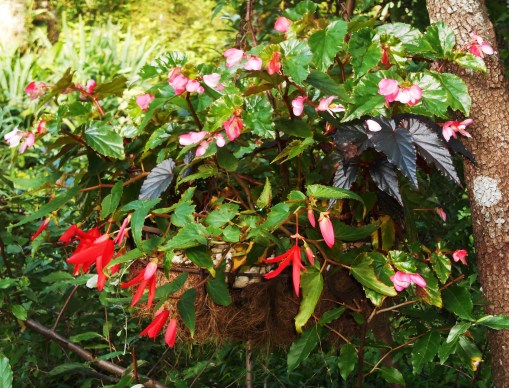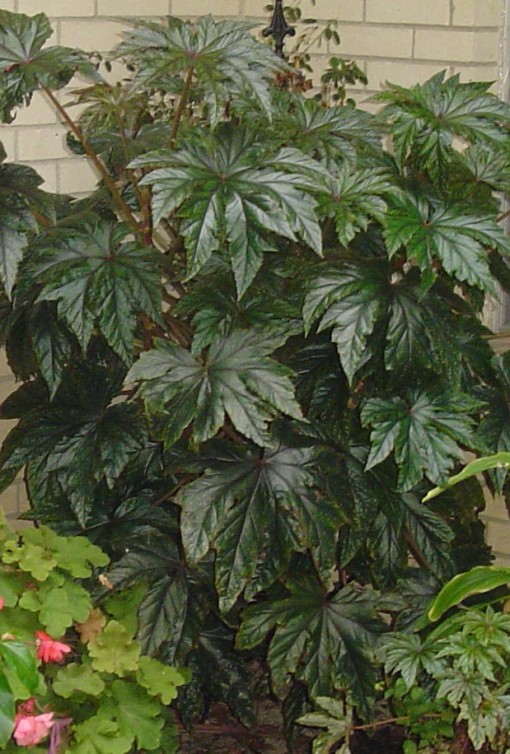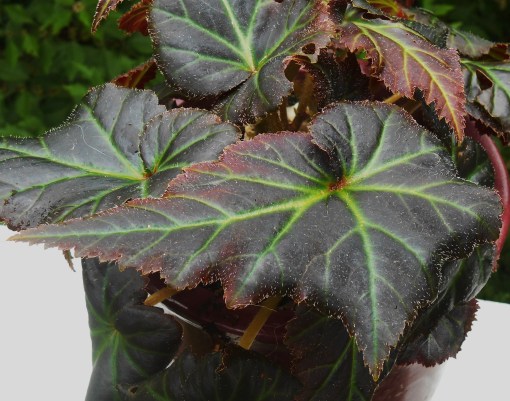~
I love Begonias. That may sound like a strange obsession for a “forest gardener”, but it is my strange obsession.
I remember buying a hanging basket of blooming Angel Wing Begonias with tiny dark burgundy and green leaves at the farmer’s market when I was living in a third floor walk up. It made my small screened in porch more beautiful, and made me happy. Since then, I’ve always had a soft spot for adding beautiful Begonia plants to my collection.
~

The first bloom of the season on a tuberous Begonia. The catalog advertised this as a cascading variety, but the growth is vigorous and upright.
~
There are thousands of cultivars in the genus Begonia. Whether grown for their outrageous leaves or their abundant bright flowers, Begonias can be found from tiny to tremendous.
~

Begonia bolivienses in partial sun. When the soil is too wet the stems will rot off at soil level. Weeks of rain will do that….
~
Begonias work in a forest garden because they appreciate shade. Although some, like the new Dragon Wing cultivars and Begonia bolivienses can take hours of sun each day, most are quite happy growing in permanent shade. They also require very little care.
~

Three different Begonia cultivars share this basket with a rabbits foot fern. The Begonia boliviensis usually dies back by late summer, but returns from its tuber the following spring. This baskets spends the winter months in our garage.
~
Most like to dry out a little between waterings. They stand up to the heat and humidity of my Virginia forest garden partly because they originate in the mountainous tropical forests of Central and South America and Southern Asia.
~
~
Although some cultivars of hardy Begonia are available, which survive the winter here in zone 7B and return each spring; most Begonias are tender perennials and must spend the winter inside where the temperatures don’t drop below the mid 40s. They are happy growing in the house, where they get some daylight from windows, and bloom happily throughout the winter.
~

Begonia boliviensis from a rooted cutting
~
Many of my Begonias overwinter in a sunny garage. They may lose a few leaves when moved out into the garden in the spring, but bounce back quickly with new leaves once they adjust to the brighter light.
~
~
Garden centers are full of bedding Begonias, Begonia Semperflorens, and Dragon Wing Begonias in the spring. Begonia Semperflorens, also known as Wax Begonias or Whiskey Begonias, are popular because these small, neat plants produce an abundance of small red, pink, or white flowers during the entire growing season. They may have light or dark green leaves, variegated leaves or even dark purple leaves. Flowers may be single or double, but all are fairly small.
~

~
New hybrids are available that maintain the flower form and leaf shape on much larger plants that may grow to 24″ in a single season.
~

Begonia ‘Gryphon’, grown in a protected shady corner, began the season in a 4″pot, and and grew this large by September.
~
Many commercial landscapers fill huge beds with these plants, but often plant them in too much sun. When they get too much sun and dry out the foliage browns and looks ratty. Growth is stunted, and the plants lose their beauty. These plants are easy to start from stem cuttings. There are some varieties with variegated foliage which trail more than they grow upright. I love these in hanging baskets growing in partial sun.
~
~
Dragon Wing Begonias have also become common spring plants in big box stores and are easy to grow. They can take sun or shade and are covered in red or pink flowers all season. They also root easily from a stem cutting in moist soil or in water. This means you can break off a stem, push it into moist potting soil, keep it shaded and moist for several weeks, and expect it to grow into a new plant. Dipping the stem cutting in powdered rooting hormone before planting speeds the process.
~

Begonia “Gryphon” is new to the market. Widely available for only the past three years, it is grown for its huge foliage. My first Gryphon grew to 4 feet tall from a 4″ pot in a single season. Putting all of its energy into leaves, I’ve never seen it flower. This is from a cutting taken from my original plant.
~
Angel Wing, or cane Begonias, are a little harder to find. Specialty and mail order nurseries are the most reliable sources. These Begonias are grown more for their huge, bright leaves than for their flowers.
~
~
Marked with silver, burgundy, and various greens, these wing shaped leaves often grow on red stems and have dark red undersides. Angel Wing Begonias produce clusters of flowers in white, pink, red, or orange. Sometimes there are 50 or more tiny flowers in a single cluster. Angel Wing cane Begonias can grow into small shrubs and can top out over 6’ tall after several years of growth.
~

Rex Begonia
~
Rex Begonias are also grown for their leaves, but stay much smaller than cane Begonias. Many of the leaves are textured, intricately marked with color, and some even grow into spirals with a snail shell appearance. Rex Begonias flower, but are insignificant on most cultivars.
~
~
Tiny Rex Begonia plants can often be found in the houseplant section of big box hardware stores. Sold in 2.5”- 6” pots, often with just a few leaves, these tiny starts will grow into impressive plants indoors or out. Pot them up so the soil will drain, feed them, give them bright but filtered light, and they take off and become beautiful plants.
~

Tuberous Begonia
~
Tuberous, or double, Begonias are grown for their large, bright flowers. These are extremely popular in Europe. Tubers are offered through catalogs all winter and show up in big box stores in late winter alongside other summer bulbs and tubers. By early May the plants begin to appear, blooming, in better garden centers. The Homestead Garden Center in James City Co. always offers a beautiful assortment of Dragon Wing and Tuberous begonias at very affordable prices. http://www.homesteadgardencenter.com
~

Tuberous Begonia foliage
~
The tubers are started in shallow trays of soil, like Caladium tubers, and then repotted into baskets or pots once they sprout. The concave side of the tuber should be up, and covered with a shallow layer of soil of not more than a half- inch. Top with vermiculite or grit in a shallow layer to control mold. Water in lightly, and place in a bright spot to watch for new stems to appear.
Upright or cascading, these hybrids are bred for outrageously beautiful flowers in every shade of red, pink, white, yellow, and orange, and their beautiful leaves. Double, triple, picotee, and fringed, these flowers can mimic roses, water lilies, and anemones. When kept watered and fed, they bloom for months.
~

~
Sadly, this is the hardest Begonia for me to grow, because they absolutely must have the proper moisture. If they get too dry, they droop. Too wet, they rot. Sometimes too many rainy days makes the stems begin to rot at the soil line, and they are very susceptible to mold and fungus. I’ve killed more than my share of these beautiful plants, and am cautious in buying them.
~

A dark leaved Tuberous Begonia shares a pot with Oxalis.
~
Hardy Begonias are beautiful in a shady border. These are technically “tuberous” Begonias, as they have an enlarged area at the bottom of each stem underground which survives the winter, but these plants are very easy to grow. These make their re-appearance each year in the late spring and can grow to 18”-24” by late summer. Several new cultivars of hardy Begonias have come to market in recent years.
~

Begonia grandis, perennial Begonias finally bloom by late summer.
~
They bloom, like an Angel Wing Begonia, with clusters of white or pink flowers and increase each year. Interestingly, they self sow and new plants often crop up in other parts of the garden. These are beautiful grown in beds with fern and Hosta and are a good plant to grow on top of spring bulbs. Watch for the tiny red bulbils that form where leaf meets stem by late summer. Each of these bulbils can grow into a new plant.
~

Hardy Begonia grandis has naturalized in our garden. It spreads, but is never invasive.
~
Begonias grow quickly and make beautiful displays either alone, or in potted arrangements with other shade loving plants. Although heavily hybridized over the last century, most cultivars retain the tough constitution of the forest plants originally collected from the mountains of South America and Asia by determined collectors who loved Begonias enough to search them out in the wild and bring them home to Europe and North America.
~
~
Some specialty growers, like Logees Growers, offer specialized information about growing Begonias. Although Begonias are in some ways a ‘cult’ plant like daffodils and Iris, there isn’t a great body of literature about them that is easily accessible. The Queensland Begonia Society, in Queensland Australia, offers a very thorough resource for Begonia lovers. They also share photos from their Begonia shows. Please visit their site for excellent articles on Begonia care and propagation, and for their stunning photos of the Begonias in their care.
Networking is important for acquiring new plants and learning the fine points of growing Begonias. I remain grateful to my Begonia loving friends for sharing cuttings and wanting to help over-winter these tender perennials.
~

Dragonwing Begonias grow well in this shady spot at the Williamsburg Botanical Garden.
~
I commonly turn to several Begonia varieties for summer interest in pots I tend at the Williamsburg Botanical Gardens. Rooted cuttings are easy to establish in mid-spring in shaded pots alongside ferns, Caladiums, and other shade-loving plants. Friends often help out by adopting the plants in November before frost touches them.
~

Begonia ‘Flamingo’
~
Begonias remain some of the most beautiful, versatile and easy to grow plants for gardeners to use in pots, beds and borders. New ones come to the market each year, ensuring that there are always new and interesting varieties available for those who like to try new plants. With so many old favorites, the greatest challenge is to find space to grow them all.
Woodland Gnome
updated January 2021
~

Begonia, “Sophie”







I just read down through this post and saw the picture of ‘Sophie’ at the bottom. I’d bought three begonias, as small plugs, just a few months ago and that name rang a bell. I checked my plant and it is labelled ‘Sophie Louise’. Since I share your love for Begonias, I’ve spent quite a bit of time trawling for information about them and one of the resources I found was the American Begonia Society, who on their website have a link to what they grandly call The International Database of the Begoniaceae. Search on ‘Louise’ and you get ten hits, including ‘Sophie’, which is a tuberous type, and ‘Sophie Louise’, which is a cane type with pictures that look pretty much like yours and my plants, which are, I think, the same. Mine has one small leaf, I can’t wait for it to get bigger, it looks fabulous.
I still haven’t decided whether to join the ABS, there’s a lot of info on their website for free, but it’s not a lot of money.
Hi Jim, That is fascinating information about B. ‘Sophie.’ I ordered it from an online catalog several years ago and was very excited to get it because the plant is fabulous. Mine grow to 5′-6′ tall (because I let them…) and have huge, beautiful leaves. I’ve started several new plants from stem cuttings over the years and I just love their flowers. I wasn’t aware of the name B. ‘Sophie Louise,’ but will check that out. It was sold to me simply as ‘Sophie.’ Mine is definitely a large cane type and has such gorgeous markings on the leaves. Thank you for the nudge to look at the ABS website again. It has been a few years since I’ve had a look, and as much as I love growing Begonias, I haven’t yet joined. None of my Begonias are bedded out in the ground because we have problems with both deer and voles. They are all in pots and I’ll be bringing them indoors tomorrow. Such a hard thing to do when the weather is as lovely as it is today. But we have a front coming with temps in the 30s by the weekend, so today and tomorrow are ‘moving day’ for my tropical perennials. Great to hear from you, Jim. I hope that your ‘Sophie’ gives you as much joy as mine does. Best, -WG
What an enjoyable and informative article about begonias! I love them, particularly the rex ones. Logee’s Greenhouse in CT has an amazing variety of begonias. Are you familiar with them? I only grow the hanging variety outdoors in summer, let them die back in the fall, then store them in the cellar. In the garden, the slugs decimate them and in the house in winter, it is too dry and cool at night (below 60) so I’ve not had great luck with them. Perhaps one day, I’ll attempt a terrarium with a heating cable!
Dear Eliza,
Thank you for the kind words. I enjoy growing all sorts of Begonias, and get a bit carried away over them sometimes. They have such lovely leaves. I’m familiar with Logee’s, but haven’t purchased any Begonias from them. I’ll give them another look 😉 Are you describing tuberous Begonias as the hanging variety? It must be easier to grow them in the more northern climates. I can never keep those going for long at all. It sounds like you can carry them from year to year. Have you tried cane Begonias? They can survive in cold down into the 50s at night, with occasional dips into the 40s. I’ve kept several plants going in our unheated but bright garage for the last several winters. They would likely make it near a window in your home. With the pots on a tray of pebbles, with water, you can manage the humidity. It may be worth a try if you love them. Take a look at Sophia, who just bloomed for the first time a few weeks ago https://forestgardenblog.wordpress.com/2014/03/18/b-sophia-has-bloomed/
Thank you for visiting Forest Garden, Eliza. I’m looking forward to catching up on your site. Best wishes, WG
Yes, it is a tuberous form with orange pendulous blooms, B. boliviensis ‘Firecracker’. I bought it impulsively several years ago and it had three 2″ corms in the pot. This will be its fourth summer. One corm perished so I have two and they measure at least 5″ across! Last year I put only one in the pot and another in the ground and the slugs weren’t too bad. I need ducks or more toads!
I have had angel wing and some monstrous cane begonia with large flat leaves with burgundy undersides (?) in the past, and found it a challenge to keep them from becoming gangly. I have a running battle with scale and they love begonias. I don’t use chemical sprays, so either I wipe them off constantly or throw the plant out. I have a rather Darwinian approach to gardening I’m afraid! 😉
One must sometimes… it is all in how much time you have to lavish on them, I believe. I’ve been growing B. “Firecracker” for the last few years and admire its tenacity in the heat. A Begonia which can take sun is a real gem! Best wishes, wG
Pingback: Time To Come In | Forest Garden
Pingback: A Beautiful Day For Ducks, Ferns and Flowers | Forest Garden
Hi there! This is an excellent and lovely post indeed. Thank you for blogging about gorgeous begonias.
As far as SoundEagle knows, the related article http://williamrheameredith.wordpress.com/2013/07/21/welcome-to-tuberous-begonias/ that you cited above is no longer available as the author(s) has/have deleted the site.
Happy October to you!
Thank you so much for letting me know about the link, Sound Eagle.
I changed the related links earlier this morning, and created a special link back to the Queensland Begonia Society site so everyone who visits my page can easily find your. Begonia growers unite 🙂 Best wishes, WG
Pingback: Begonias, Begonias | Queensland Begonia Society
Reblogged this on Queensland Begonia Society.
Pingback: Hardy Begonias | Forest Garden
Definitely a nice flower with many varieties.